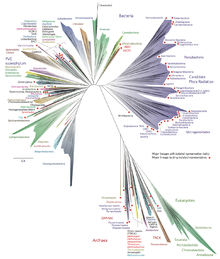
The two-domain system is a biological classification by which all organisms in the tree of life are classified into two domains, Bacteria and Archaea.[1][2][3] It emerged from development of knowledge of archaea diversity and challenges the widely accepted three-domain system that classifies life into Bacteria, Archaea, and Eukarya.[4] It was preceded by the eocyte hypothesis of James A. Lake in the 1980s,[5] which was largely superseded by the three-domain system, due to evidence at the time.[6] Better understanding of archaea, especially of their roles in the origin of eukaryotes through symbiogenesis with bacteria, led to the revival of the eocyte hypothesis in the 2000s.[7][8] The two-domain system became more widely accepted after the discovery of a large group (superphylum) of Archaea called Asgard in 2017,[9] which evidence suggests to be the evolutionary root of eukaryotes, thereby making eukaryotes members of the domain Archaea.[10]
While the features of Asgard archaea do not completely rule out the three-domain system,[11][12] the notion that eukaryotes originated within Archaea has been strengthened by genetic and proteomic studies.[13] Under the three-domain system, Eukarya is mainly distinguished by the presence of "eukaryotic signature proteins" that are not found in Archaea and Bacteria. However, Asgard archaea contain genes that code for multiple such proteins.[3]
- ^ Bolshoy, Alexander; Volkovich, Zeev (Vladimir); Kirzhner, Valery; Barzily, Zeev (2010), "Biological Classification", Genome Clustering, Studies in Computational Intelligence, vol. 286, Berlin, Heidelberg: Springer Berlin Heidelberg, pp. 17–22, doi:10.1007/978-3-642-12952-0_2, ISBN 978-3-642-12951-3, retrieved 2022-05-14
- ^ Raymann, Kasie; Brochier-Armanet, Céline; Gribaldo, Simonetta (2015). "The two-domain tree of life is linked to a new root for the Archaea". Proceedings of the National Academy of Sciences of the United States of America. 112 (21): 6670–6675. Bibcode:2015PNAS..112.6670R. doi:10.1073/pnas.1420858112. PMC 4450401. PMID 25964353.
- ^ a b Nobs, Stephanie-Jane; MacLeod, Fraser I.; Wong, Hon Lun; Burns, Brendan P. (2022). "Eukarya the chimera: eukaryotes, a secondary innovation of the two domains of life?". Trends in Microbiology. 30 (5): 421–431. doi:10.1016/j.tim.2021.11.003. PMID 34863611. S2CID 244823103.
- ^ Doolittle, W. Ford (2020). "Evolution: Two Domains of Life or Three?". Current Biology. 30 (4): R177 – R179. Bibcode:2020CBio...30.R177D. doi:10.1016/j.cub.2020.01.010. PMID 32097647.
- ^ Lake, James A. (1988). "Origin of the eukaryotic nucleus determined by rate-invariant analysis of rRNA sequences". Nature. 331 (6152): 184–186. Bibcode:1988Natur.331..184L. doi:10.1038/331184a0. PMID 3340165. S2CID 4368082.
- ^ Archibald, John M. (2008). "The eocyte hypothesis and the origin of eukaryotic cells". Proceedings of the National Academy of Sciences. 105 (51): 20049–20050. Bibcode:2008PNAS..10520049A. doi:10.1073/pnas.0811118106. PMC 2629348. PMID 19091952.
- ^ Poole, Anthony M.; Penny, David (2007). "Evaluating hypotheses for the origin of eukaryotes". BioEssays. 29 (1): 74–84. doi:10.1002/bies.20516. PMID 17187354.
- ^ Foster, Peter G.; Cox, Cymon J.; Embley, T. Martin (2009). "The primary divisions of life: a phylogenomic approach employing composition-heterogeneous methods". Philosophical Transactions of the Royal Society of London. Series B, Biological Sciences. 364 (1527): 2197–2207. doi:10.1098/rstb.2009.0034. PMC 2873002. PMID 19571240.
- ^ Zaremba-Niedzwiedzka, Katarzyna; Caceres, Eva F.; Saw, Jimmy H.; Bäckström, Disa; Juzokaite, Lina; Vancaester, Emmelien; Seitz, Kiley W.; Anantharaman, Karthik; Starnawski, Piotr (2017). "Asgard archaea illuminate the origin of eukaryotic cellular complexity" (PDF). Nature. 541 (7637): 353–358. Bibcode:2017Natur.541..353Z. doi:10.1038/nature21031. OSTI 1580084. PMID 28077874. S2CID 4458094.
- ^ Eme, Laura; Spang, Anja; Lombard, Jonathan; Stairs, Courtney W.; Ettema, Thijs J. G. (10 November 2017). "Archaea and the origin of eukaryotes". Nature Reviews Microbiology. 15 (12): 711–723. doi:10.1038/nrmicro.2017.133. ISSN 1740-1534. PMID 29123225. S2CID 8666687.
- ^ Da Cunha, Violette; Gaia, Morgan; Nasir, Arshan; Forterre, Patrick (2018). "Asgard archaea do not close the debate about the universal tree of life topology". PLOS Genetics. 14 (3): e1007215. doi:10.1371/journal.pgen.1007215. PMC 5875737. PMID 29596428.
- ^ Zhou, Zhichao; Liu, Yang; Li, Meng; Gu, Ji-Dong (2018). "Two or three domains: a new view of tree of life in the genomics era". Applied Microbiology and Biotechnology. 102 (7): 3049–3058. doi:10.1007/s00253-018-8831-x. PMID 29484479. S2CID 3541409.
- ^ Williams, Tom A.; Cox, Cymon J.; Foster, Peter G.; Szöllősi, Gergely J.; Embley, T. Martin (2020). "Phylogenomics provides robust support for a two-domains tree of life". Nature Ecology & Evolution. 4 (1): 138–147. doi:10.1038/s41559-019-1040-x. PMC 6942926. PMID 31819234.
